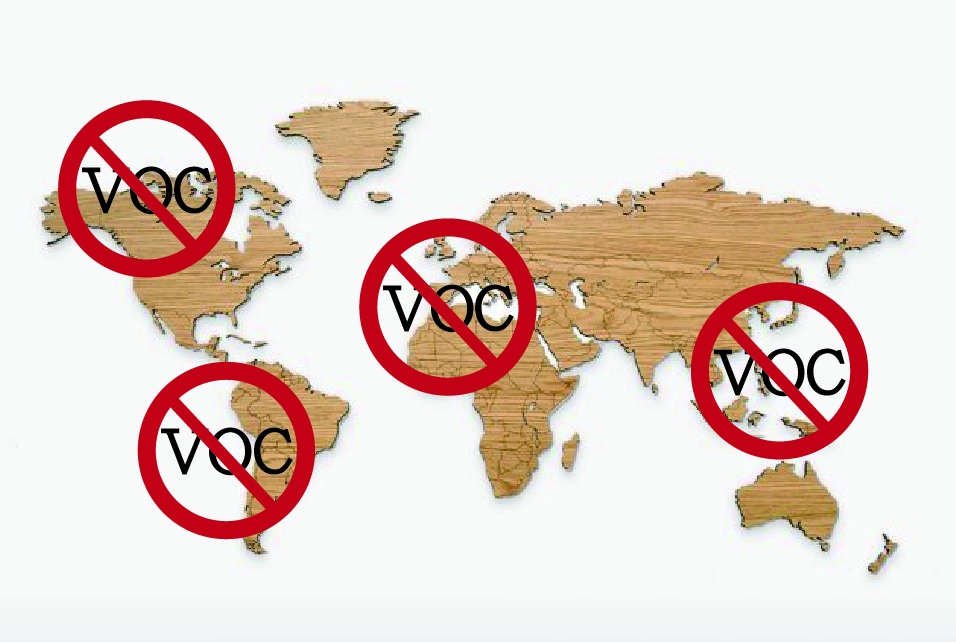How printers from different parts of the world are treating VOCs emission?

VOCs (Volatile organic compounds) are found in many of the inks solvents and cleaning solvents across the printing and packaging industry. Research have indicated that VOCs are harmful to the human body when inhaled directly in the air, or when inhaled after it has gone through a chemical reaction under sunlight and heat to form O3(ozone).
The action trend taken to reduce the VOCs emission by printers across the globe varies depending on factors such as, the regulation intensity of the region, the technology advancement of the region, the environmental consciousness level of the demographics. In some parts of the world not much attention is being placed into VOCs emission reduction. In some parts of the world aggressive measures are taking place. In general, there are three ways to treat VOCs. 1. Targeting the issue from the source (raw materials), for instance changing from solvent inks to water-based inks 2. Targeting the issue by adopting a more environmentally friendly printing process, for instance changing from rotogravure process to flexographic process. 3. To target the issue by installing VOC converting or recycling equipment.
Vietnam
In emerging markets like Vietnam, the legal system on environmental protection is just starting to take shape. Inspection, monitoring, testing methodologies are still under progression. The government has recognized the plan for the industrial zone with appropriate policies, mandating companies to invest in infrastructure for pollution treatment, environmental analysis and to provide reports on the operation of waste treatment. Lastly, through education to raise environmental awareness and social responsibilities of the citizens in the region.
Currently, the dominant printing process in the region is the rotogravure process on solvent inks with minimal investment placed into VOC converting or recycling equipment.
Taiwan
Taiwan has recognized the VOCs emission issues for more than a decade. Since 2007, regulations have been placed onto the market to charge fees for VOCs emission. Monetary incentives for VOCs emission reduction were put in place to motivate businesses in reducing their emission levels each year. The fee structure is categorized into three different emission levels and by the different seasons. On average a 100-ton emission would cost the business TWD6.1 million ~ TWD 13.16 million a year to the government. The high cost has created an incentive for the local business to switch from the Rotogravure process over to Flexographic. How is that? On average a rotogravure, solvent-based ink has around 80% more VOC solvents than a flexographic solvent-based ink. Based on this reduction, switching over to the flexographic and targeting the issue from the source(inks), this could lead to an annual savings of TWD4.88 million ~ TWD10.52 million.
Japan
Culturally speaking, Japan is a market that emphasizes heavily on beautiful packaging to create alluring product presentations. In the past where the print image quality of the Flexographic process is inferior to the Rotogravure process; leading the market to widely adopt the Rotogravure process. However, environmental awareness and the sense of social responsibility is high in the region. Though Voluntary VOCs Emissions-Reduction program in the society, the region has successfully reduced the VOCs emission by 40% over a 10-year period from the year 2000 to 2010. So why did these businesses participate in the voluntary program besides cost reason? The reduction of VOCs emission reduces the odor from these hazardous gases and reduce the risk of fire. As result creating a safer work environment and more satisfied workers. Reducing VOCs create less trouble with the local resident caused by pungent odors. Reducing VOCs is beneficial in building up a better public image from a corporate social responsibility standpoint.
The main methodology adopted today in Japan to treat VOCs is through converters and recycling equipment added to the Rotogravure printing process. However, this may change in the future due to the increasing print quality from the Flexographic process.
USA
USA is a great example for a country targeting the VOCs issue right from its source and process where the Flexographic printing process is the mainstream. According to Smithers Pira, Flexographic print value accounts for 30.4% of the market share in the region. Water-based inks are also much more widely adopted in the region when compared to the Asian region.


























